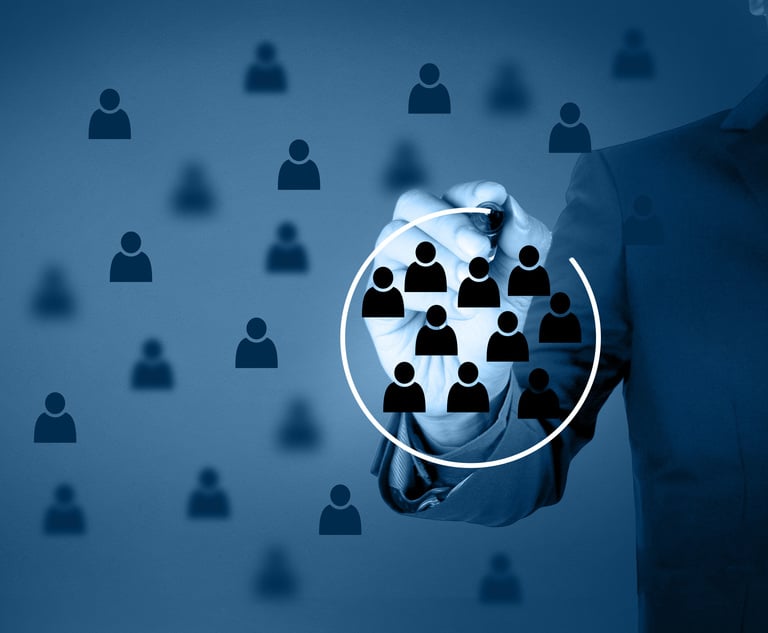At Midsize Firms, It Pays to Give Millennials a Voice
It's not just the biggest or the richest firms that are finding new ways to get the most out of their youngest lawyers.
November 27, 2017 at 04:44 PM
20 minute read
 Getty Images/iStockphoto
Getty Images/iStockphoto This story is part of a series exploring how law firms and others in the legal industry are adapting to manage their millennial workers, from recruitment and real estate to training and technology and beyond. Read the overview here.
While they still make up a small percentage of law firm partners, millennials are helping to transform what it means to make a career in the law. Many of the largest firms in the country have trumpeted millennial-friendly policies and programs, including remote work accommodations for associates, committees for junior partners and in-house innovation labs involving young lawyers, to name just a few examples.
 But regional and midsize firms are also evolving to accommodate—and to take advantage of—the generational shift.
But regional and midsize firms are also evolving to accommodate—and to take advantage of—the generational shift.
Sandberg Phoenix & von Gontard, a 140-lawyer firm based in St. Louis, recently hosted its first “Idea-a-thon,” in which associates competed to generate the best improvements to the law firm's operations and culture. The firm also created a millennial task force, which serves as a liaison to leadership.
Sandberg Phoenix managing partner Bhavik Patel said the Idea-a-thon idea came from looking at how successful tech companies brainstorm.
“We didn't create any limitations or restrictions,” Patel said. They simply split 50 associates into four groups and asked them to memorialize their discussions to share with firm leadership later.
Some of the ideas they generated have already been put in place.
After the Idea-a-thon, Sandberg Phoenix created an Uber allowance, so lawyers can feel more comfortable attending networking events outside work hours without having to drive home late in the night. The firm implemented a “nanny” allowance, as well, also aimed at helping lawyers with families cover babysitting costs, so they can develop business at after-hours events. It created a vacation credits program, in which lawyers can get billable credit just for taking time off.
The vacation credits are aimed at alleviatiating “the feeling of going on vacation but knowing you have to make it up,” Patel said. “There are some associates who will get 80 or 100 hours reduced from their budget … that allows them to truly check out.”
At Burr & Forman, a 290-lawyer regional firm based in Birmingham, Alabama, managing partner Ed Christian created a 10-lawyer associate advisory committee when he became managing partner earlier this year. Christian estimated that all of the firm's 86 associates are millennials, as well as some junior partners.
The committee has proposed several changes so far, including alternate work schedules for lawyers with family obligations and an expansion of the paternal leave policy. Those improvements are underway, Christian said.
“When you have a good chunk of revenue generators who are doing well, you want to do whatever you can to encourage that and make it happen,” he said.
Subtle Changes
Unlike their larger counterparts, midsize and regional firms are less likely to have a human resources staff that can dedicate substantial energy to millennial-focused initiatives. And few can afford to attract millennial associates with salaries that match their Big Law counterparts in major markets.
But gathering young lawyers and giving them a platform to voice their opinions requires few resources. Adjusting to millennials doesn't require an extreme makeover, or providing costly benefits without hesitation.
“They didn't come back with a list of demands,” Christian said of his associate committee. “They came back saying, 'We want to do things to make the firm better.'”
Christian said Burr & Forman already had some of the programs in place that millennial associates were asking for. They just hadn't advertised them. For instance, the committee wanted to know whether the firm would allow associates to choose a nonpartner track while remaining full-time, something the firm had implemented previously in specific cases.
“I think they like concreteness. They want to know what's there and see it,” he said.
Mathieu Shapiro, managing partner of Philadelphia-based Obermayer Rebmann Maxwell & Hippel, made a similar observation, saying much of what his firm's millennial lawyers want are the same things their predecessors in Generation X fought for, like the dissolution of traditional gender roles in the workplace and a balance between work and personal life.
The biggest change at Obermayer Rebmann, he said, is “the ability to do meaningful work from anywhere, and at anytime.” Like many firms, Obermayer Rebmann has expanded remote work options for lawyers as millennials have entered the legal landscape.
“That's one place you kind of see the generational divide,” Shapiro said. “Particularly baby boomers like to have associates sitting on the other side of the desk. Millennials I don't think get that at all.”
Happier Millennials = Healthy Firms
According to data from ALM Intelligence, almost 90 percent of associates are millennials (born between 1981 and 1999). So efforts at associate outreach mostly touch that generation. These young lawyers may not have seniority, but law firm leaders are increasingly seeing value in keeping them happy.
“At the end of the day, attorney retention, associate retention, associate loyalty and growth is how the law firm is going to make money over the long run,” Patel said. “Bluntly, happier associates results in more money, and better-satisfied clients.”
Instead of fighting the generational differences, the firm leaders said, it's better to embrace them, and capitalize on each generation's strengths.
Christian noted some of his associates' strong points. They're tech savvy, which has helped as the firm works on a new brand strategy, he said, and many are more entrepreneurial at a young age.
“They're interested and inquisitive and want to know about the business of running a law firm,” Christian said. “It is certainly different from when I was an associate 20 years ago. I came, did the work in front of me and went home. … I was told at the time, don't worry about business development.”
Shapiro agreed. The millennial traits that often earn eyerolls from older generations—their desire to be constantly connected with the world around them, or their cravings for frequent feedback—do not have to be weaknesses.
“There's nothing bad about any of those things. I think all of those things can be used to the benefit of the firm and our clients,” he said.
 Getty Images/iStockphoto
Getty Images/iStockphoto This story is part of a series exploring how law firms and others in the legal industry are adapting to manage their millennial workers, from recruitment and real estate to training and technology and beyond. Read the overview here.
While they still make up a small percentage of law firm partners, millennials are helping to transform what it means to make a career in the law. Many of the largest firms in the country have trumpeted millennial-friendly policies and programs, including remote work accommodations for associates, committees for junior partners and in-house innovation labs involving young lawyers, to name just a few examples.
 But regional and midsize firms are also evolving to accommodate—and to take advantage of—the generational shift.
But regional and midsize firms are also evolving to accommodate—and to take advantage of—the generational shift.
“We didn't create any limitations or restrictions,” Patel said. They simply split 50 associates into four groups and asked them to memorialize their discussions to share with firm leadership later.
Some of the ideas they generated have already been put in place.
After the Idea-a-thon,
The vacation credits are aimed at alleviatiating “the feeling of going on vacation but knowing you have to make it up,” Patel said. “There are some associates who will get 80 or 100 hours reduced from their budget … that allows them to truly check out.”
At
The committee has proposed several changes so far, including alternate work schedules for lawyers with family obligations and an expansion of the paternal leave policy. Those improvements are underway, Christian said.
“When you have a good chunk of revenue generators who are doing well, you want to do whatever you can to encourage that and make it happen,” he said.
Subtle Changes
Unlike their larger counterparts, midsize and regional firms are less likely to have a human resources staff that can dedicate substantial energy to millennial-focused initiatives. And few can afford to attract millennial associates with salaries that match their Big Law counterparts in major markets.
But gathering young lawyers and giving them a platform to voice their opinions requires few resources. Adjusting to millennials doesn't require an extreme makeover, or providing costly benefits without hesitation.
“They didn't come back with
Christian said
“I think they like concreteness. They want to know what's there and see it,” he said.
Mathieu Shapiro, managing partner of Philadelphia-based
The biggest change at
“That's one place you kind of see the generational divide,” Shapiro said. “Particularly baby boomers like to have associates sitting on the other side of the desk. Millennials I don't think get that at all.”
Happier Millennials = Healthy Firms
According to data from ALM Intelligence, almost 90 percent of associates are millennials (born between 1981 and 1999). So efforts at associate outreach mostly touch that generation. These young lawyers may not have seniority, but law firm leaders are increasingly seeing value in keeping them happy.
“At the end of the day, attorney retention, associate retention, associate loyalty and growth is how the law firm is going to make money over the long run,” Patel said. “Bluntly, happier associates results in more money, and better-satisfied clients.”
Instead of fighting the generational differences, the firm leaders said, it's better to embrace them, and capitalize on each generation's strengths.
Christian noted some of his associates' strong points. They're tech savvy, which has helped as the firm works on a new brand strategy, he said, and many are more entrepreneurial at a young age.
“They're interested and inquisitive and want to know about the business of running a law firm,” Christian said. “It is certainly different from when I was an associate 20 years ago. I came, did the work in front of me and went home. … I was told at the time, don't worry about business development.”
Shapiro agreed. The millennial traits that often earn eyerolls from older generations—their desire to be constantly connected with the world around them, or their cravings for frequent feedback—do not have to be weaknesses.
“There's nothing bad about any of those things. I think all of those things can be used to the benefit of the firm and our clients,” he said.
This content has been archived. It is available through our partners, LexisNexis® and Bloomberg Law.
To view this content, please continue to their sites.
Not a Lexis Subscriber?
Subscribe Now
Not a Bloomberg Law Subscriber?
Subscribe Now
NOT FOR REPRINT
© 2025 ALM Global, LLC, All Rights Reserved. Request academic re-use from www.copyright.com. All other uses, submit a request to [email protected]. For more information visit Asset & Logo Licensing.
You Might Like
View All
Adding 'Credibility' to the Pitch: The Cross-Selling Work After Mergers, Office Openings
5 minute read
Law Firms Are 'Struggling' With Partner Pay Segmentation, as Top Rainmakers Bring In More Revenue
5 minute read

Will a Market Dominated by Small- to Mid-Cap Deals Give Rise to a Dark Horse US Firm in China?
Trending Stories
- 1Decision of the Day: Court Holds Accident with Post Driver Was 'Bizarre Occurrence,' Dismisses Action Brought Under Labor Law §240
- 2Judge Recommends Disbarment for Attorney Who Plotted to Hack Judge's Email, Phone
- 3Two Wilkinson Stekloff Associates Among Victims of DC Plane Crash
- 4Two More Victims Alleged in New Sean Combs Sex Trafficking Indictment
- 5Jackson Lewis Leaders Discuss Firm's Innovation Efforts, From Prompt-a-Thons to Gen AI Pilots
Who Got The Work
J. Brugh Lower of Gibbons has entered an appearance for industrial equipment supplier Devco Corporation in a pending trademark infringement lawsuit. The suit, accusing the defendant of selling knock-off Graco products, was filed Dec. 18 in New Jersey District Court by Rivkin Radler on behalf of Graco Inc. and Graco Minnesota. The case, assigned to U.S. District Judge Zahid N. Quraishi, is 3:24-cv-11294, Graco Inc. et al v. Devco Corporation.
Who Got The Work
Rebecca Maller-Stein and Kent A. Yalowitz of Arnold & Porter Kaye Scholer have entered their appearances for Hanaco Venture Capital and its executives, Lior Prosor and David Frankel, in a pending securities lawsuit. The action, filed on Dec. 24 in New York Southern District Court by Zell, Aron & Co. on behalf of Goldeneye Advisors, accuses the defendants of negligently and fraudulently managing the plaintiff's $1 million investment. The case, assigned to U.S. District Judge Vernon S. Broderick, is 1:24-cv-09918, Goldeneye Advisors, LLC v. Hanaco Venture Capital, Ltd. et al.
Who Got The Work
Attorneys from A&O Shearman has stepped in as defense counsel for Toronto-Dominion Bank and other defendants in a pending securities class action. The suit, filed Dec. 11 in New York Southern District Court by Bleichmar Fonti & Auld, accuses the defendants of concealing the bank's 'pervasive' deficiencies in regards to its compliance with the Bank Secrecy Act and the quality of its anti-money laundering controls. The case, assigned to U.S. District Judge Arun Subramanian, is 1:24-cv-09445, Gonzalez v. The Toronto-Dominion Bank et al.
Who Got The Work
Crown Castle International, a Pennsylvania company providing shared communications infrastructure, has turned to Luke D. Wolf of Gordon Rees Scully Mansukhani to fend off a pending breach-of-contract lawsuit. The court action, filed Nov. 25 in Michigan Eastern District Court by Hooper Hathaway PC on behalf of The Town Residences LLC, accuses Crown Castle of failing to transfer approximately $30,000 in utility payments from T-Mobile in breach of a roof-top lease and assignment agreement. The case, assigned to U.S. District Judge Susan K. Declercq, is 2:24-cv-13131, The Town Residences LLC v. T-Mobile US, Inc. et al.
Who Got The Work
Wilfred P. Coronato and Daniel M. Schwartz of McCarter & English have stepped in as defense counsel to Electrolux Home Products Inc. in a pending product liability lawsuit. The court action, filed Nov. 26 in New York Eastern District Court by Poulos Lopiccolo PC and Nagel Rice LLP on behalf of David Stern, alleges that the defendant's refrigerators’ drawers and shelving repeatedly break and fall apart within months after purchase. The case, assigned to U.S. District Judge Joan M. Azrack, is 2:24-cv-08204, Stern v. Electrolux Home Products, Inc.
Featured Firms
Law Offices of Gary Martin Hays & Associates, P.C.
(470) 294-1674
Law Offices of Mark E. Salomone
(857) 444-6468
Smith & Hassler
(713) 739-1250










